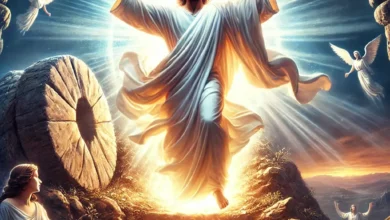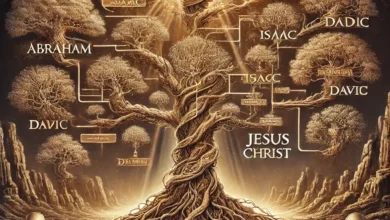
5 sentences that Jesus Christ said about his own identity
5 Statements by Jesus Christ About His Identity: When Moses encounters the burning bush in the wilderness, he approaches it and communicates with God. The conversation begins, and Moses asks an important question: “What is your name?” Moses grew up in Egypt, where every god had a name. In a conversation with a divine being, a name can reveal much information. Which god was Moses talking to? God answers with a simple sentence: “I am.” Not the god of the heavens or the seas, but the one who truly exists. The God above all.
The Israelites used this name for God, in Hebrew, Yahweh. Several thousand years later, the Son of God appears on earth, fully human and fully divine. Jesus Christ also introduces himself several times, telling us who he is. The “I am” statements from the Gospels help us answer the question, “Who is Jesus Christ?”
فرست محتوا
1. The Bread of Life:(Jesus Christ)
By saying “I am the bread of life,” Jesus Christ addresses not only physical hunger but also the deeper spiritual hunger for nourishment and eternal life. In the Old Testament, we find the foreshadowing of Jesus as the bread of life in the story of manna provided to the Israelites in the wilderness. Exodus 16 describes how God provided bread from heaven to sustain his people during their journey. This miraculous provision prefigures Jesus’ role as the ultimate source of spiritual sustenance and strength.
Furthermore, the concept of bread holds rich symbolism throughout the Old Testament, particularly in the context of offerings and sacrifices. For example, the showbread placed in the tabernacle symbolized God’s continual presence and provision for his people (Exodus 25:30). In the New Testament, Jesus Christ’s claim to be the bread of life is recorded in John 6:35, where he declares, “I am the bread of life; whoever comes to me shall not hunger, and whoever believes in me shall never thirst.”
Here, Jesus Christ presents himself as the solution to our spiritual hunger and thirst, inviting us to partake in him. In the same discourse, Jesus explains this metaphor by stating that his flesh is true food and his blood is true drink, alluding to the sacrificial nature of his impending death on the cross and the establishment of the New Covenant (John 6:51-58).
Read more : According to the Bible, are God and Jesus Christ the same person?

2. The Light of the World:
Jesus Christ’s declaration “I am the light of the world” reveals his identity as the source of spiritual illumination and guidance. This theme is found in both the Old and New Testaments: God dispels darkness and reveals the truth to us. In the Old Testament, light is often used metaphorically to symbolize God’s presence, guidance, and salvation.
Psalm 27:1 proclaims, “The Lord is my light and my salvation; whom shall I fear?” Here, God’s light represents deliverance from fear and darkness. Similarly, Isaiah 9:2 prophesies about the coming Messiah, declaring, “The people who walked in darkness have seen a great light; those who dwelt in a land of deep darkness, on them has light shone.” This prophecy foretells the coming of Jesus as the embodiment of divine light and salvation.
In John 8:12, Jesus Christ proclaims, “I am the light of the world; whoever follows me will not walk in darkness, but will have the light of life.” Here, we see that Christ’s light grants us vision and guides us on the path of life, not death. Additionally, Jesus’ ministry and teachings demonstrate his role as the light of the world. His miracles, such as restoring sight to the blind and casting out demons, show his power to overcome darkness and bring healing and wholeness to those in need (John 9:1-7, Mark 1:32-34).
3. The Door of the Sheep:
When Jesus says, “I am the door of the sheep,” he expresses his role as the only way to access God and his kingdom. This statement holds rich symbolism, using images from the Old and New Testaments to show Jesus’ unique position as the gateway to salvation and eternal life. In the Old Testament, references to doors often symbolize protection, security, and provision. Psalm 118:20 tells us, “This is the gate of the Lord; the righteous shall enter through it,” symbolizing the way to God’s presence and blessings.
In John 10:7-9, Jesus Christ claims to be the door of the sheep: “Truly, truly, I say to you, I am the door of the sheep. All who came before me are thieves and robbers, but the sheep did not listen to them. I am the door. If anyone enters by me, he will be saved and will go in and out and find pasture.”
Jesus reveals his exclusivity as the only means by which we can enter into a relationship with God and be saved. We are referred to as sheep, but not all sheep belong to God. Through repentance and faith, we become his sheep. There are other shepherds and pastures, but those leaders will abuse their sheep. We want a good shepherd, and there is only one.
4. The Good Shepherd:
When Jesus Christ says, “I am the good shepherd,” he encapsulates his role as the compassionate and self-sacrificial leader of his followers. This statement draws from the rich biblical imagery in both the Old and New Testaments to depict Jesus’ care, protection, and willingness to lay down his life for his sheep. In the Old Testament, the shepherd metaphor is often used to describe God’s relationship with his people and the qualities of a righteous leader. Psalm 23 beautifully portrays God as a shepherd who guides, protects, and provides for his flock. Additionally, Ezekiel 34:11-16 describes God as a shepherd who seeks out his scattered sheep, rescues them from harm, and ensures their well-being.
In the New Testament, Jesus Christ declares in John 10:11, “I am the good shepherd. The good shepherd lays down his life for the sheep.” Jesus demonstrates his selfless love and commitment to his followers, contrasting his sacrifice with the actions of hired hands who abandon the sheep in times of danger (John 10:12-13).
Furthermore, Jesus’ role as the good shepherd is intricately linked to his mission of redemption and salvation. In John 10:15, Jesus teaches, “Just as the Father knows me and I know the Father; and I lay down my life for the sheep.” This statement emphasizes the unity between Jesus Christ and the Father and highlights his willingness to offer himself as a ransom for the sins of humanity (Mark 10:45).

5. The Resurrection and the Life:
Jesus Christ’s words, “I am the resurrection and the life,” summarize his authority over death and his promise of eternal life for believers. Both the Old and New Testaments emphasize Jesus’ role as the source of both spiritual and physical resurrection. In the Old Testament, the concept of resurrection is hinted at in passages like Job 19:25-27, where Job expresses his faith in God’s ultimate vindication and restoration, even in the face of death. Additionally, Ezekiel 37:1-14 records the vision of the valley of dry bones, symbolizing the restoration and revival of Israel under God’s power.
Jesus arrives at the tomb of Lazarus, his friend, and in his conversation with Martha, he tells her, “I am the resurrection and the life; whoever believes in me, though he die, yet shall he live.” Christ provides tangible evidence of the resurrection to come by raising Lazarus from the dead. He later reinforces this statement with his own resurrection from the dead. In 1 Corinthians 15:20-22, the Apostle Paul affirms Jesus’ resurrection as the firstfruits of those who have fallen asleep, signifying the defeat of death and the assurance of resurrection for those who believe.





